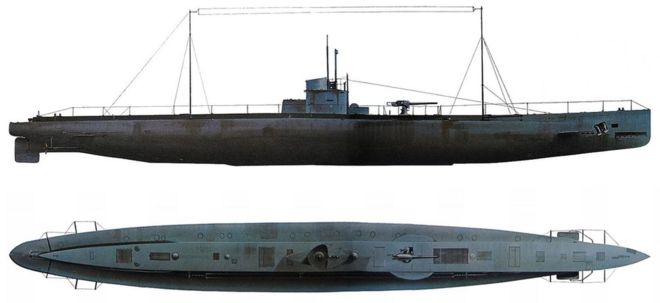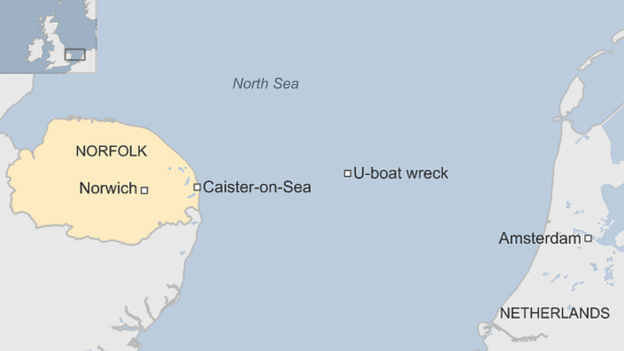Scans that were recently done by wind farm developers have shown something unexpected. The scans showed a submarine that was lying below the surface of the North Sea, about 55 miles east of Caister-on-Sea.
The scans revealed that it was a German U-Boat that had sunk in January of 1915. The name of the U-Boat was U-31; it had struck a mine in the North Sea and sank, taking 35 men with it. Up until now, its whereabouts were unknown.
Since this wreck is considered a military maritime grave, it will remain there untouched and unsalvaged. There are no plans for excavating the submarine.

U-31 was actually the first of 11 subs in this class. They were commissioned by the Imperial German Navy between the years of 1912 and 1915.
The U-Boats were numbered 31 to 41. Three of them had surrendered during the war and eight of them sank. Up until now, the whereabouts of the U-Boats that sank were unknown. There are still seven of them out there somewhere.
Scans of the seabed where U-31 was found have turned up nearly 60 wrecks in just two years. A majority of those wrecks were known to exist, but U-31 was a complete surprise for the historians and archaeologists.
At first glance, the archaeologists thought that the wreckage was a Dutch Navy submarine which had been missing since June, 1940. In order to confirm whether or not the submarine was, in fact, Dutch, the archaeologists had to make several dives. After diving, they were surprised to find that it was not a Dutch vessel, but German.

After U-31 was found, a diving team from Lamlash North Sea Diving captured clear footage of the boat. It still sits in the North Sea about 98 feet below the surface.
U-31 was one of 375 German submarines and U-Boats that were a part of World War I. The submarines had a range of almost 8,000 nautical miles, and their sailors could spend almost five days on war patrol. However, they would have only 72 hours worth of air supply.
About 202 U-boats were lost in action during the war. Over 17,000 men served on the U-boats, and 5,100 of them had lost their lives.
When U-31 left Wilhelmshaven, Germany on a routine patrol on January 13, 1915, it simply disappeared. Many people believe that it hit a mine and sank, killing all men on board.
After the diving team got their footage, they measured U-31 as 190 feet long, 13 feet wide, and 19 feet high. The bow had been damaged after sinking and debris that was found surrounding the wreckage site is believed to have been a part of the bow, which means the ship could have measured up to 230 feet long.
One of the divers on the team, Mr. Dunkley, said that for being underwater for over a century, the boat has stayed in extraordinary condition. He also said that now that U-31 has finally been found, the descendants of the men who lost their lives in the wreckage can have some peace and comfort knowing where the resting place is. It is considered yet another grave for those lives lost at sea.
Now that the site has been found, it is unsure whether or not windfarming will continue in the area or not. However, the company assures that the wreckage will not be disturbed.
It is safe to say that hundreds of U-boats and submarines were sunk during World War I. Here is a list of U-boats that went down during only the one year of 1915.
January 13:

U-31 There were no survivors and the final resting place of the submarine has recently been found.
January 21:
U-7 24 people died in the wreck and there was only one survivor. The ship was misidentified and torpedoed off the Dutch coast.
March 4:
U-8 No one died since the boat only got trapped in fishing nets. It was forced to surface and was most likely abandoned.
March 10:
U-12 There were 20 people who died and 10 who survived the wreck when this sub was rammed and shelled by a destroyer off of Fife Ness.
March 18:
U-29 There were 32 who died, as the whole crew to went down with their ship. It was rammed by HMS Dreadnought in Pentland Firth.
April 30:
U-37 Again, there were 32 people who died and no survivors. It was mined while making its journey back home near the Sandettie Bank.
May 23:
U-3 Fourteen people died and there were no survivors. The final fate of the ship is unknown, but it is believed that it was lost in the Aegean Sea.
June 5:
U-14 One person died and the other 27 people managed to survive. The ship was disabled by gunfire from an armed trawler.
June 23:
U-40 There were 29 people on board and there were no survivors. The ship was torpedoed by HM Sub C24.
June 30:
UC-2 There were 15 on board and no one survived. It was destroyed by the detonation of one of their own mines off Yarmouth.
July 20:
U-23 There were 24 people on board and 10 managed to survive. It was torpedoed by HM Sub C27.
July 24:
U-36 Out of the 18 on board, no one survived. It was sunk by gunfire from Q-Ship Prince Charles.
August 15:
UB-4 Out of the 15 on board there were also no survivors. It was sunk by gunfire from Q-Ship Inverlyon off Yarmouth.
August 19:
U-27 There were 37 people on board and no one survived. It was sunk by gunfire from Q-Ship Baralong.
August 30:
U-26 There were no survivors of the 30 people on board. It was mined off Hanko, Finland.
September 15:
U-6 There were 24 people on board and five survived. It was torpedoed by HM Sub E16 off Stavanger.
September 24:
U-41 Two people survived of the 35 people on board. It was sunk by gunfire from Q-Ship Baralong.
October 20:
UC-9 There were 14 people on board and no survivors.
November 4:
UC-8 The death toll is unknown. It ran aground on the Dutch coast.
November 29:
UC-13 The whole crew survived after it went aground in a storm off Bosphorus.
Sources:
http://www.bbc.com/news/uk-england-norfolk-35370700
http://uboat.net/wwi/fates/losses.html